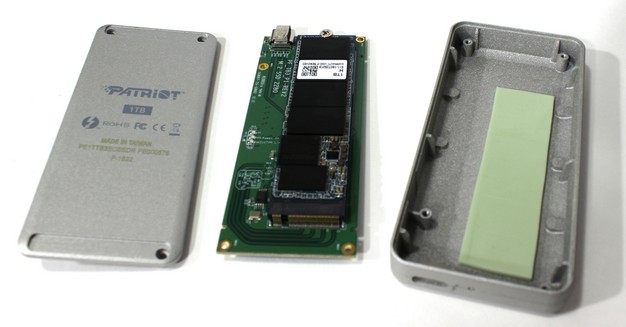Patriot EVLVR Portable Thunderbolt 3 SSD Review: Sleek, Snappy, Solid
Patriot EVLVR NVMe TB3 SSD: Disassembly And Component Analysis
We pulled apart the Patriot EVLVR to show you exactly what was inside of the 1TB model we evaluated...
With the metal enclosure disassembled we find that the standard 2280 form factor SSD resides on a small PCB, with a Thunderbolt connector one end and a M.2 connector to slot-in the SSD on the other.

The underside of the PCB is home to most of its components. The largest chip is the Intel Thunderbolt 3 controller model JHL6340. This model is a PCIe Gen 3 interface controller supporting up to 3 lanes. The other chip of note is the Texas Instruments TP865983, which is a USB-C controller. This is important to note as the older Type C controller model TI82 from Texas Instruments had problems with MAC compatibility early on, so this newer model should work well and not suffer from such issues.
Here we have the M.2 drive itself. It is based on the Phison 5008-E8 controller, which rests between a bit of DRAM cache and the NAND flash memory.

Here is a better look at the Phison PS5008-E8, which is a PCIe Gen 3x2 controller capable of around 1,600MB/s Seq read and 1,100MB/s Seq writes. The NAND is Toshiba TABBG55AIV, which we have seen before on drives like the Corsair Force 510. This NAND is 256GB per package, manufactured at 15nm, and is 3-bit per cell TLC. The controller from Phison is a DRAM capable model supporting 2, 4, 6 or 8GB of DRAM. As it is configured here, the EVLVR leverages 2GB of Micron DRAM, model MT41K128M16JT-125 for those who are interested.
It is somewhat odd that a PCIe x2 drive/controller was used when Patriot offers NVMe PCIe x4 drives that would have offered better performance, but the decision to use a x2 drive was probably the result of the TB3 controller's x3 lane configuration, since one of the lanes on an x4 drive would have essentially gone to waste. Using the x2 drive also helps bring down the price point.









